Skin Conditions
Dairy cattle can suffer from a number of skin conditions which cause inflamed, irritated or scaly skin, hair loss, changes in pigmentation of the coat or skin or visible growths
The most common conditions of the skin in dairy cattle include:
- Ringworm
- Warts
- Photosensitisation
- Abscess
- Lice
- Fly irritation
Dairy cattle in subtropical or tropical region of Australia may also be affected by:
- Buffalo fly
- Cattle tick
Ringworm
What to look for
- Round, grey-whitish, bald areas of the skin about 2-6cm in size
- Most often seen on the head (especially around the eyes), neck and near the udder
Cause
Ringworm is caused by a fungus called Trichophyton verrucosum.
Animals likely to be affected
Young stock are most likely to be affected by ringworm. Inadequate nutrition and immune suppression due to diseases such as Bovine Viral Diarrhoea Virus (BVDV) increases susceptibility to infection.
Confirming the diagnosis
Ringworm is usually distinctive and a diagnosis can generally be based on the appearance of the skin changes.
How it spreads
Animals become infected with ringworm directly from other animals or from rubbing on fences, trees, buildings and other objects contaminated with ringworm fungal spores.
Risks to people
People can be infected with cattle ringworm, so it is important to pay attention to personal hygiene when handling infected animals.
Treatment
Ringworm usually clears up within one to four months without any treatment. Farmers particularly concerned because of a planned sale or appearance at cattle show can speed up healing by scrubbing the lesions with 5% iodine solution and a stiff brush. Individual animals severely affected by warts should be tested by a veterinarian for underlying immune suppressing diseases such as BVDV.
Risk factors
Inadequate nutrition and immune suppression from diseases such as BVDV increase the risk of ringworm in dairy cattle.
Prevention
The spread of ringworm may be reduced by isolating infected animals and ensuring adequate nutrition is provided. Dairy Australia's Heifers on Target resources can be used to assess whether the diet is meeting the nutritional needs of young stock.
Warts
What to look for
- Dry nodules or ‘cauliflower’ appearing lumps
- Commonly on the head, neck and shoulders
- Can vary greatly in size or join together
- Can also occur on the teats of older cattle or the penis of bulls
Cause
Warts are caused by a range of viruses called papillomaviruses.
Animals likely to be affected
Warts are more common in dairy cattle less than two years-old. Warts may occur on the teats of adult dairy cattle.
Confirming the diagnosis
Warts are usually distinctive and a diagnosis can usually be based on the appearance of the skin changes.
How it is spread
Warts spread by direct contact with infected animals after damage or a break in the skin.
Risks to people
Warts of dairy cattle are a different strain to those in people so are not transmissible.
Treatment
Treatment is rarely needed and warts disappear within a couple of months. Individual animals severely affected by warts should be tested by a veterinarian for underlying immune supressing diseases such as BVDV. Bulls with warts on the penis may require veterinary treatment and should not be used until they have recovered.
Prevention
There is no specific prevention for warts of young stock. Warts on teats may be prevented by ensuring all surfaces of the teats are covered with teat disinfectant after every milking. More information about teat disinfectant can be found on the mastitis page.
Photosensitisation
What to look for
- Sudden onset of redness and swelling of non-pigmented skin
- Severe irritation and seeking shade
- Severely affected animals will be in significant pain and have a high temperature
- Over time, affected skin may start to slough
Cause
There are several possible causes of photosensitisation. These include:
- Facial eczema
- St John’s wort
- Ragwort
- Blue green algae
- Lantana
- Mouldy forages
- Lush ryegrass (‘spring eczema’)
Animals likely to be affected
Dairy cattle of all ages can be affected by photosensitisation.
Confirming the diagnosis
Photosensitisation is usually distinctive and a diagnosis can be based on the appearance of skin changes.
If cattle are affected in late summer and autumn in Gippsland or the Bega Valley the cause is likely to be facial eczema.
The diagnosis may also be aided by a history of exposure to causative plants or toxins.
Blood testing by a veterinarian can often narrow down the cause.
How it spreads
Animals develop photosensitisation due to ingestion of toxins that react directly on the skin or damage the liver, causing secondary photosensitisation.
Treatment
Treatment should involve identifying and removing the cause. Affected animals should be housed undercover or be provided with access to shade during the day and allowed to graze at night.
Anti-inflammatories and antihistamines may reduce pain and irritation of the skin. Applying a sun blocking ointment registered for use in dairy cattle may also assist.
Risk factors
- Located in Gippsland or the Bega Valley (facial eczema)
- Late summer or autumn (facial eczema)
- Exposure to toxic plants, algae or funguses
Prevention
Specific recommendations for the prevention of facial eczema can be found here. Prevention of other causes of photosensitisation include controlling weeds, preventing access to toxic plants and using alternative drinking water sources if blue-green algae is present.
Abscess
What to look for
- Large pus-filled swellings
- May occur anywhere on the body
- Often soft in the early stages, becoming harder over time
Cause
Abscesses are usually caused by a bacterial organism called Arcanobacterium pyogenes.
Animals likely to be affected
Abscesses can occur in dairy cattle of any age.
Confirming the diagnosis
Abscesses can be diagnosed by carefully inserting a new large gauge needle into the swelling and withdrawing pus.
How it spreads
Abscesses are not contagious.
Treatment
Treatment involves lancing the abscess generously and draining. The abscess may need to be flushed repeatedly with diluted iodine or other antiseptic to prevent reformation. Antibiotics are rarely required.
Risk factors
- Use of contaminated needles
- Vaccination of wet cattle
- Some vaccines with an oily base
- Use of calcium preparations to treat milk-fever
- Feeding hay or pasture with awns such as barley grass
Prevention
Abscesses may be prevented by addressing the risk factors outlined above.
Lice
What to look for
- Scratching against fences, gates, feed and water troughs, trees etc
- Hair loss, particularly on the neck and back
Cause
Lice are a parasite that live and feed on the skin of dairy cattle. Several different species of lice occur in Australia.
Animals likely to be affected
Dairy cattle of all ages are susceptible to lice but young, poorly fed animals are likely to be the most heavily infested.
How it spreads
Lice are spread by close contact with other infested cattle.
Risks to people
Cattle lice cannot be spread to people.
Treatment
Most lice infestations do not require treatment. Where animals are severely affected, they should be treated with an insecticide registered for the treatment of lice. These are usually an injection or pour-on. There are also sprays/showers and ear tags for treatment of lice.
Risk factors
- Cool, moist weather
- Poor nutrition
- Underlying disease
Prevention
Ensuring good nutrition is likely to be helpful in preventing lice. Dairy Australia's Heifers on Target resources can be used to assess whether the diet is meeting the nutritional needs of young stock.
Fly irritation
This section describes irritation caused by stable and bush flies.
What to look for
- Large numbers of flies on the skin of cattle
- Irritation, stomping, tail swishing, head flicking
Cause
The primary flies causing irritation of dairy cattle in southern Australia include stable flies, blow flies and bush flies.
Animals likely to be affected
Dairy cattle of all ages are susceptible to fly irritation.
Risk factors
- Decaying vegetation, silage and effluent drainage areas (stable fly)
- Warm, humid weather
Treatment
Treatment for fly irritation involves the use of a pour-on product registered for control of stable fly, house fly and lice.
Prevention
Prevention is aimed at maintaining farm hygiene and the use of residual insecticides in the resting/breeding places of the flies.


